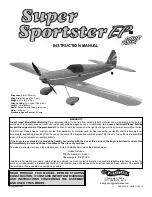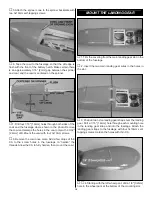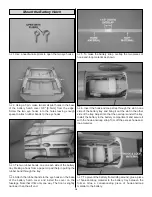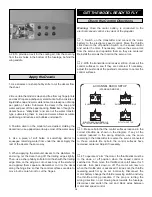
❏
4. Fold a piece of masking tape over the other end of the
string and draw an arrow on it. With the stab centered on the
fuselage, slide the tape along the string and align the arrow
with one tip of the stab. Swing the string over to the same
position at the other end of the stab. If the arrow doesn’t
align with the tip, adjust the stab and the arrow slightly and
check both tips again. Adjust the stab until the stabilizer tips
and the trailing edge are centered.
❏
5. View the stab from approximately 10' [3m] behind
the plane. Check that the stab is parallel with the wing. If it is
not, lightly sand the stab saddle until the stab is parallel with
the wing.
❏
6. Use a fine-point felt-tip pen to mark the outline of the
fuselage onto the bottom and top of the stab.
❏
7. Remove the stab from the fuselage. Use a sharp #11
hobby knife or the Expert Tip that follows to cut the covering
from the stab just inside the lines you marked. Use care to
cut only the covering and not the wood. Cutting the wood
will weaken the stab and it may break in flight.
HOW TO CUT COVERING FROM BALSA
Use a 25 watt soldering iron to cut the covering from the stab.
The tip of the soldering iron doesn’t have to be sharp, but a
fine tip does work best. Allow the iron to heat fully. Use a metal
straightedge to guide the soldering iron at a rate that will just
melt the covering and not burn into the wood. The hotter the
soldering iron, the faster it must travel to melt a fine cut. Allow
the heat to melt the covering. Do not apply much pressure or
the wood may be damaged. Peel off the covering.
❏
8. The same as you did for the wing and aileron, cut the
covering from the hinge slots in the stab and elevator halves.
There are four hinge slots in the stab/elevator and two in the
fin/rudder. Drill a 3/32" [2.4mm] hole through the center of
each hinge slot.
10










































